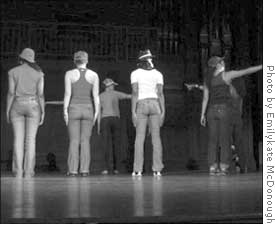
| << Front page | Arts | April 8, 2005 |
A LARGE CRITIC
 |
||
| Africa Now: Performers got back in Wednesday night’s Colors of Rhythm multicultural show. | ||
The Oberlin Musical Theater Association has done it again. For a while, that phrase did not come with a positive connotation. However, I’m pleased to report that, with the successful performance of Songs for a New World this weekend, OMTA is on the rise. Beginning with their production of The Fantastics, OMTA has rattled off a series of successful performances, and Songs for a New World is no exception.
Songs is not a musical in the traditional sense. Really, it is more like a cabaret revue without an MC. There is no spoken dialogue and no unifying narrative between numbers. The intimate setting of Little Theater aids this type of show. The actors make significant eye contact with the audience and directly address their songs to those surrounding them; when first-year Courtney Merrill tries to reassure us that “David loves her,” she’s actually trying to convince us, not some fictional audience member in the third balcony.
The ensemble numbers are enjoyable, but the best moments come in the form of solos. Sophomore Julienne Walker, performing “Stars and the Moon,” was beguiling, chronicling her attempts to find happiness. By casually tossing out her askance smile and sideways looks, she sets us up adeptly for the realization that, to sound cliché, she has been looking for love in all the wrong places.
Sophomore Andrew Owens also excelled in his solo about the inability to break up with someone when you are so close to them. While folding his female partner’s “delicates,” he displays just the right amount of frustration and resignation; he hides his love for her well, but just poorly enough to give the audience a glimpse of how much he truly cares for her.
Turning out another strong musical performance, junior Maggie Keenan-Bolger showed her well-practiced skill at playing a range of characters. Her anger in “The Flagmaker, 1775” is even more surprising because it comes from the diminutive body that flashed wide eyes and an expectant smile in the very recent past. Her ability to play such a wide range of ages and attitudes should serve her well in her future productions.
Frequently overlooked but nevertheless essential, this technical crew was outstanding. Junior Caleb Baker’s lighting scheme was outstanding, transforming a simple platform set into a garden, a sailing ship and a ledge on the 52nd floor of a city building. His lighting and transitions are one of the primary reasons that this production is so strong.
The only soft spots in the production seem to come from the director’s chair. Sophomore Annie Mosbacher should have given more attention to the movement of her actors. When there was deliberate choreography, it looked slightly awkward. It appeared that when the actors were left to themselves, some of them, particularly the men, defaulted to a limited repertoire of semi-epic gyrations. Also, her appearances on stage were unneeded.
She stands in and performs one solo but fails to appear in group numbers,
save the final one. By doing so, she becomes an intruder and breaks us away from
the five performers with whom audiences come to connect. Certainly, any of the
three talented female cast members would have been able to take on the roles
assumed by Mosbacher.
About us
Subscriptions
Advertising